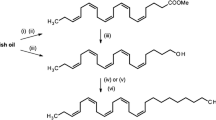Abstract
The primary pheromone (E,E)-8,10-dodecadien-1-ol (I, codle-mone), 11 further alcohols, and binary blends of both were evaluated for attractiveness as defined by the percentage ofL. pomonella males showing oriented upwind flight terminated by landing at the source within 10 min after release. Sources of I were attractive from 10−5 μg to 101 μg, with approx. 70% males responding at 10−3−10−1 μg. Most other alcohols also showed attractiveness, but the dose-response curves differed greatly with respect to the range of effective lure doses as well as the maximum response level reached at any dose. (E,E)-7,9-Undecadien-1-ol (III) revealed a dose-response curve similar in shape to I but shifted towards higher concentrations. (E,E)-8,10-Tridecadien-1-ol (II) and (E)-8,10-undecadien-1-ol (IV) exhibited threshold values of 10−5 μg (same as for I) and were effective over, respectively, seven and nine decades of source load, but they did not reach a response level of 40% at any test amount. (E)-9,11-Dodecadien-1-ol (VI) and the monoenes (E)-8-, (E)-10-, and (Z)-10-dodecen-1-ol (VIII-X) showed weak attractivity restricted to one to three test doses. Upwind approaches that broke off a few centimeters from the source were rarely seen in tests with I but frequently occurred with some of the analogs. When combined with 10−3 μg of I, all alcohol analogs showed “inhibitory” properties, although the amounts required to obtain a significant lowering of response differed by up to 105-fold. This amount was the lowest (10−4 μg) for the positional isomer VI, and the highest (101 μg) for undecan-1-ol (XI) and dodecan-1-ol (XII). With some mixtures, the presence of the inhibitor appeared to cause an alteration in landing behavior. No synergistic effects were seen in these tests. The results are briefly considered with respect to the sensory perception of the test stimuli and the involvement of minor components in the female pheromone blend.
Similar content being viewed by others
References
Arn, H., Schwarz, C., Limacher, H., andMani, E. 1974. Sex attractant inhibitors of the codling mothLaspeyresia pomonella L.Experientia 30:1142–1144.
Arn, H., Guerin, P.M., Buser, H.R., Rauscher, S., andMani, E. 1985. Sex pheromone blend of the codling moth,Cydia pomonella: Evidence for a behavioral role of dodecan-1-ol.Experientia 41:1482–1484.
Bartell, R.J., andBellas, T.E. 1981. Evidence for naturally occurring, secondary compounds of the codling moth female sex pheromone.J. Aust. Entomol. Soc. 20:197–199.
Batiste, W.C., Olson, W.H., andBerlowitz, A. 1973a. Codling moth: Diel periodicity of catch in synthetic sex attractant vs. female-baited traps.Environ. Entomol. 2:673–676.
Batiste, W.C., Olson, W.H., andBerlowitz, A. 1973b. Codling moth: Influence of temperature and day-light intensity on periodicity of daily flight in the field.J. Econ. Entomol. 66:883–892.
Beroza, M., Bierl, B.A., andMoffitt, H.R. 1974. Sex pheromones: (E,E)-8,10-Dodecadien-1-ol in the codling moth.Science 183:89–90.
Castrovillo, P.J., andCardé, R.T. 1979. Environmental regulation of female calling and male pheromone response periodicities in the codling moth (Laspeyresia pomonella).J. Insect Physiol. 25:659–667.
Einhorn, J., Beauvais, F., Gallois, M., Descoins, C., andCausse, R. 1984. Constituants secondaires de la phéromone sexuelle du carpocapse des pommes,Cydia pomonella L. (Lepidoptera, Tortricidae).C.R. Acad. Sci. Paris 299:773–778.
Einhorn, J., Witzgall, P., Audemard, H., Boniface, B., andCausse, R. 1986. Constituants secondaires de la phéromone sexuelle du carpocapse des pommes,Cydia pomonella L. (Lepidoptera, Tortricidae). II. Première approche des effets comportementaux.C.R. Acad. Sci. Paris 302:263–266.
George, D.A., Mcdonough, L.M., Hathaway, D.O., andMoffitt, H.R. 1975. Inhibitors of sexual attraction of male codling moths.Environ. Entomol. 4:606–608.
Guerin, P., Arn, H., andBuser, H.-R. 1985. Characterization of some tortricid sex pheromones using the insect antenna as a gas Chromatographie detector, pp. 239–250,in T.E. Acree and D.M. Soderlund (eds.). Semiochemistry: Flavors and Pheromones. W. de Gruyter, Berlin.
Hathaway, D.O., Mcgovern, T.P., Beroza, M., Moffitt, H.R., McDonough, L.M., andButt, B.A. 1974. An inhibitor of sexual attraction of male codling moths to a synthetic sex pheromone and virgin females in traps.Environ. Entomol. 3:522–524.
Howell, J.F., Hutt, R.B., andHill, W.B. 1978. Codling moth: Mating behavior in the laboratory.Ann. Entomol. Soc. Am. 71:891–895.
Mani, E., Riggenbach, W., andMendik, M. 1974. Tagesrhythmus des Falterfangs und Beobachtungen über die Flugaktivität beim Apfelwickler (Laspeyresiapomonella L.).Mitt. Schweiz. Entomol. Ges. 47:39–48.
Roelofs, W., Comeau, A., Hill, A., andMilicevic, G. 1971. Sex attractant of the codling moth: Characterization with electroantennogram technique.Science 174:297–299.
Roelofs, W.L., Bartell, R.J., Hill, A.S., Cardé, R.T., andWaters, L.H. 1972. Codling moth sex attractant—field trials with geometrical isomers.J. Econ. Entomol. 65:1276–1277.
Wong, T.T.Y., Cleveland, M.L., Ralston, D.F., andDavis, D.G. 1971. Time of sexual activity of codling moths in the field.J. Econ. Entomol. 64:553–554.
Author information
Authors and Affiliations
Rights and permissions
About this article
Cite this article
Preiss, R., Priesner, E. Responses of male codling moths (Laspeyresia pomonella) to codlemone and other alcohols in a wind tunnel. J Chem Ecol 14, 797–813 (1988). https://doi.org/10.1007/BF01018774
Received:
Accepted:
Issue Date:
DOI: https://doi.org/10.1007/BF01018774




